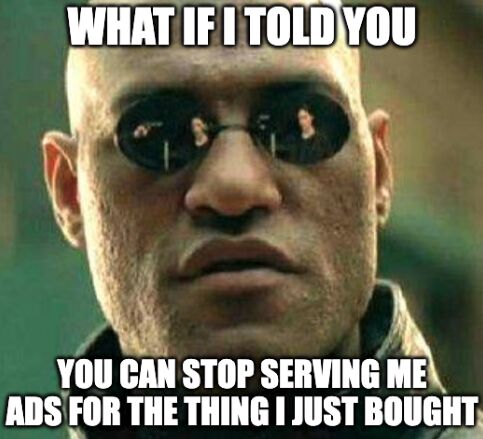Ask your marketing team (or yourself, if you’re on the marketing team) this simple question: “How do you send offline conversions?”
If the answer is either, "We don’t" or “Via manual CSV uploads," then you have both a data security issue and an ads optimization issue. 😬
With third-party cookies sunsetting, ad blockers, and privacy-centric browsers like Brave, marketers are finding it more difficult than ever to measure campaigns AND critically send conversion data back to ad platforms for ads optimization around conversion actions.
In this attribution guide, we’ll show you how to set up Google offline conversions, a vital method to track and measure advertising efforts. Of course, Google offline conversions offer a semi-permanent fix for this tracking effort – there’s no guarantee they’ll be here forever, but my bottom dollar is we’ve got at least five years – but this is 🔑 to advertisers’ success in circumstances where it may be (extra) challenging to get attribution.
Note: This guide can serve as a template for sending offline conversions to Meta Ads, Twitter Ads, TikTok Ads, Reddit Ads, Microsoft Ads, GA4, LinkedIn Ads, and a variety of programmatic platforms like The Trade Desk, but we’ll start with using first-party data for Google Ads attribution via offline conversions.

How do offline conversions work?
With offline conversions, advertisers can send conversion data to Google Ads, allowing them to see a complete picture of the impact their advertising is having on their business. This data can also be used to optimize their campaigns by identifying which keywords, ad placements, and targeting strategies are driving the most valuable offline actions.
Putting this 👆 all together: Offline conversions build audiences (e.g., everybody who did the conversion action). Depending on where these users land in the conversion funnel, they can be used for remarketing or ad exclusions. And with offline conversion-based audiences, you can ensure you’re not annoying users with ads after they make a purchase. 🤪
The superpower of using first-party data for offline conversions is that you can blend different data entities. 🦸 Imagine this B2B use case:
- You want to combine business intelligence data like a user “score” with conversion data like a form submission.
Or
- You could combine these two 👆to make a high-quality offline conversion to send to Google.
Traditionally, a marketer would only capture the form submission, missing the critical quality association needed for better B2B ads optimization. But when they’re armed with the ability to track and measure offline conversions, advertisers can make more informed decisions about how to allocate their advertising budgets and improve the overall ROI of their online advertising efforts.
Building the measurement and attribution dream team 🤩
With third-party cookies sunsetting and ad blockers being built into devices (looking at you, iOS 14 and later 👀), gone are the days when a semi-technical marketer could set up conversions via Google Tag Manager or simple code placement on a site/in an app. Instead, first-party data sent as offline conversions is the best path to Google Ads attribution.
Keep in mind: First-party data spans different teams, so you’ll most likely need measurement champions from the following teams 👇
- Marketing & Advertising. As the owner of Google Ads, this team is critical in defining, requesting, and testing conversion events.
- Web. Your website developer will likely play a role in capturing things like the GCLID and ensuring it’s passed along to relevant destinations.
- Product. Your product manager knows your product's onboarding process like the back of their hand. ✋ This person will help you identify the most important conversion points on the onboarding journey.
- RevOps. This team can give you real financial data on how much a conversion is worth if you’re not in e-commerce. Note that this number may need to be estimated.
- Data & Analytics. You’ve got an analytics owner, right? Like product, they should be able to provide conversion data and – more crucially – conversion rates between different steps in the funnel, which may all have their own conversion value (e.g. views product, adds a product to cart, views cart, views billing page, checks out).
- Engineering. Should you have a product, engineering may need to help with implementation. Most likely, your product manager can facilitate this, but getting engineering in on conversion tracking early will certainly make the final implementation not fall into the “square peg round hole” dilemma. You want to do attribution right and have the tracking last.
- Project Management. This effort might be a major undertaking, and in that case, a good project manager is worth their weight in gold. Acting as a translator and resource allocator among different teams, the buck stops with the product manager. Be sure to treat them with kindness and empathy. Wrangling so many disparate teams is hard work!
Once you have your dream team assembled, you can start sending Google Ads Attribution as offline conversions from your data warehouse (Snowflake, BigQuery, PostGres, Redshift, MySQL, etc.) to Google Ads. Note that this method only works if you have a data warehouse, but if not, you can also use Google Sheets in a pinch. 🤏
Of course, like everything in life, there’s the traditional (but difficult) way to do this — or you can take the new, easy-breezy approach. 😏
The traditional (but hard) way to set up Google Offline Conversions via the Google Conversion API
Setting up Google offline conversions with a conversion API involves a few steps and requires some technical expertise. Here’s a general overview of the process, but we’ll leave the nitty-gritty technical write-up of this to Google.
- Prepare your data. You'll need to have a way to collect data about offline conversions and store it in a format that can be uploaded to Google Ads. This may involve setting up a CRM system, creating a custom spreadsheet, or using a third-party integration.
- Set up conversion tracking. To upload offline conversion data, you first need to have conversion tracking set up in Google Ads. This involves creating a conversion action for the type of conversion you want to track, such as a phone call or in-store purchase.
- Create an offline conversion upload file. Once you have your offline conversion data ready, you'll need to create a file that can be uploaded to Google Ads. This involves formatting your data into a specific structure and including certain required fields, such as the conversion date and value.
- Upload your data. Once your file is ready, upload it to Google Ads through the Offline Conversions section of the Conversion Actions page.
- Verify and monitor your conversions. After you've uploaded your data, you'll need to verify that it was processed correctly and monitor your offline conversion data in Google Ads to ensure it's accurate and up-to-date.
Again, this is just a speed run of the process, and the exact steps may vary depending on your specific situation and the tools you're using. You may also need to work with a developer or technical expert to set up and implement offline conversion tracking correctly.
The easy way to set up Google offline conversions with first-party data from your data warehouse (in just four steps)
Now, if you want to make life difficult for yourself and go it the hard way, more power to you. The folks at Census, on the other hand, created a quick, streamlined approach to achieve the same results. Just follow the steps in the example below to start sending offline conversions from Snowflake to Google Ads. 👇
- Great a free Census Account (Census is a data activation platform with a ready-made connection from your data warehouse to Google Ads, you can create and send a basic set of offline conversions on the free plan).
- Connect your data warehouse to Census.
- Connect your Google Ads account to Census.
- Send your offline conversions, so you finally have Google Ads attribution!
- If you’re reading this as a marketer or data person, you know these “events” don’t define themselves. Ensure you’ve determined what offline conversion(s) you want to send.
- For additional guidance and technical details, hop over to Census docs - Google Offline Conversions, or schedule a demo with a product expert, and they’ll run you through the setup.
Or if you’d rather watch a step-by-step visual guide on how to send your offline conversions from Snowflake to Google Ads, check out this video.👇
The future of Google attribution
No matter how you slice and dice it, offline conversions are the future of Google Ads Attribution. 🔮 You could, of course, throw up your hands and ignore attribution and hope for the best. But this would take you back to the days before Claude Hopkins introduced Scientific Advertising in 1923, which included strategies for attribution around putting unique coupons on different marketing assets.

Without offline conversion data, you’re giving up on the promise of machine learning and ads conversions optimization that is getting more and more reliable on Google Ads. And now that you’re armed with the tools to set up Google Ads offline conversions, be sure to pay it forward and tell your friends and colleagues.
✨ Have feedback on this article, or want a personalized data activation strategy session? Schedule a jam session with a Census data activation expert. We’ll show you just how easy it can be to combine different data entities into single conversion events.


















